| Movements within Art Nouveau | Art Nouveau of Belgium and France | Catalan Modernisme | Modern Style and Glasgow School in Britain | Secession and Jugendstil in Northern and Central Europe | Stile Liberty , Tiffany Style and other local variations | Image |
|---|
| 1887 | | Güell Pavilions featuring trencadís technique were finished by Antoni Gaudí in Barcelona | | | |  |
|---|
| 1888 | | Castle of the Three Dragons was built by Lluís Domènech i Montaner for Universal Exposition in Barcelona | | | |  |
|---|
| 1890 | | Palau Güell* [1] was finished [2] by Antoni Gaudí in Barcelona | | | Stained-glass window Education was created by Louis Comfort Tiffany's Tiffany Glass Company for Yale University |  |
|---|
| 1892 | | Casa Botines was completed by Antoni Gaudí and Llorenç Matamala i Piñol in León | | Munich Secession was founded by 96 artists in Munich | |  |
|---|
| 1893 | Hotel Tassel* by Victor Horta [3] [4] [5] and Maison Hankar by Paul Hankar were completed in Brussels | Mercat de la Llibertat was built by Miquel Pascual i Tintorer and Francesc Berenguer i Mestres in Barcelona | The Studio magazine was founded by Charles Holme in London | | |  |
|---|
| The poster for Grafton Galleries was drawn by Eugène Grasset in Paris |  |
| 1894 | Salon des Cent was founded by Léon Deschamps in Paris | The Vile Club was painted by Ramon Casas in Barcelona | | | "The Inland Printer" magazine cover was created by Will H. Bradley |  |
|---|
| 1895 | Maison de l'Art Nouveau was opened by Siegfried Bing in Paris | | | Pan magazine was founded and published by Otto Julius Bierbaum, Julius Meier-Graefe, and Richard Dehmel in Berlin | |  |
|---|
| A poster for Gismonda by Alphonse Mucha was published in Paris |  |
| 1896 | The poster for the cabaret Le Chat noir was created by Theophile-Alexandre Steinlen in Paris | Casa Martí was built by Josep Puig i Cadafalch in Barcelona | | Simplicissimus and Jugend magazines were founded by Albert Langen and Georg Hirth respectively in Munich | |  |
|---|
| The Bloemenwerf was completed [6] [7] by Henry Van de Velde in Brussels | The Museum of Applied Arts was finished by Ödön Lechner in Budapest |  |
| 1897 | Art & Décoration magazine was founded in France | Els Quatre Gats cafe featuring interior by Ramon Casas was opened in Barcelona | | Vienna Secession was founded by Gustav Klimt, Koloman Moser, Josef Hoffmann, Joseph Maria Olbrich, and others and was joined by Otto Wagner in Vienna | | 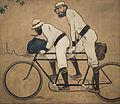 |
|---|
| International Exposition was held in Brussels | Bodegas Güell were built by Antoni Gaudí in Garraf (Sitges) | Five Swans tapestry was completed by Otto Eckmann |  |
| 1898 | The Castel Béranger was completed by Hector Guimard in Paris | | The Fox and Anchor building was built by Latham Withall and William James Neatby [8] in London | The Secession Hall was finished by Joseph Maria Olbrich, Koloman Moser, and Othmar Schimkowitz in Vienna | Mir iskusstva artistic movement was founded by Alexandre Benois, Konstantin Somov, Dmitry Filosofov, Léon Bakst, and Eugene Lansere in Saint Petersburg |  |
|---|
| The "Dragonfly Lady" brooch was made by René Lalique | The first issue of Ver Sacrum magazine with cover by Alfred Roller was published in Vienna |  |
| 1899 | Nature Unveiling Herself Before Science was sculpted by Louis-Ernest Barrias in Paris | A house for Ramon Casas is built by Antoni Rovira i Rabassa in Barcelona [9] | The Ruchill Church Hall [10] and Queen's Cross Church [11] were finished by Charles Rennie Mackintosh in Glasgow | Darmstadt Artists' Colony* was founded by Ernest Ludwig, Grand Duke of Hesse in Darmstadt, German Empire | Mir iskusstva started issuing the eponymic magazine edited by Sergei Diaghilev in Saint Petersburg | 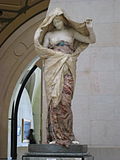 |
|---|
| The first extension of Hôtel van Eetvelde* [5] was finished [12] by Victor Horta in Brussels | Karlsplatz Stadtbahn Station by Otto Wagner and Joseph Maria Olbrich was finished [13] in Vienna | "Mikula and Volga" maiolica fireplace was initially created by Mikhail Vrubel and Peter Vaulin |  |
| 1900 | Metro station entrances by Hector Guimard , Gare de Lyon and its decorated buffet were built for the Exposition Universelle in Paris | Casa Rull was completed by Lluís Domènech i Montaner in Reus | | Villa Schutzenberger was completed by Julius Berninger and Gustav Krafft in Straßburg, German Empire | American Hotel was completed by Willem Kromhout and Herman Gerard Jansen in Amsterdam |  |
|---|
| The 3 Square Rapp building was finished by Jules Lavirotte and Alexandre Bigot in Paris | Casa Amatller was finished by Josep Puig i Cadafalch in Barcelona | Ernst Ludwig House (now hosting Darmstadt Colony Museum [ de ]) was completed by Joseph Maria Olbrich and Peter Behrens in Darmstadt, German Empire |  |
| 1901 | Victor Horta finished [14] his own house and atelier* [5] in Brussels | Ramon Casas and Pere Romeu in an Automobile was painted by Ramon Casas in Barcelona | The building of Everard's Printing Works by Henry Williams and William James Neatby was finished in Bristol | Gödöllő Art Colony was founded by Aladár Körösfői-Kriesch in Gödöllő, Kingdom of Hungary | Bakhrushins Tenement House [ ru ] was finished by Karl Hippius in Moscow |  |
|---|
| École de Nancy was founded in Nancy | Porta i tanca de la Finca Miralles [ ca ] was built by Antoni Gaudí in Barcelona | The Windy Hill house was completed by Charles and Margaret Macdonald Mackintosh in Kilmacolm, Scotland | Kullervo Rides to War was painted by Akseli Gallen-Kallela in Grand Duchy of Finland |  |
| 1902 | The Villa Majorelle was finished by Henri Sauvage, Louis Majorelle, and Alexandre Bigot in Nancy | Casa Lleó Morera was completed by Lluís Domènech i Montaner in Barcelona | | XIV Secession exhibition featured Beethoven Frieze by Gustav Klimt, sculpture by Max Klinger and works of Alfred Roller, Adolf Böhm and other artists [15] in Vienna | Exposition of Modern Decorative Arts was held in Turin, Kingdom of Italy |  |
|---|
| The Niké Brooch was made by Philippe Wolfers | Subotica Synagogue was finished by Marcell Komor [ hu ] and Dezső Jakab in Szabadka (now Subotica, Serbia) | Casa Fenoglio-Lafleur was finished by Pietro Fenoglio in Turin, Kingdom of Italy |  |
| 1903 | Interior works were finally finished [16] in Hôtel Solvay* [5] by Victor Horta in Brussels | The Gran Hotel was completed by Lluís Domènech i Montaner in Palma de Mallorca | The Willow Tearooms were built by Charles Rennie Mackintosh in Glasgow | Wiener Werkstätte was founded by Josef Hoffmann and Koloman Moser in Vienna | Eliseyev Emporium was built by Gavriil Baranovsky in Saint Petersburg |  |
|---|
| Maison Saint-Cyr was finished by Gustave Strauven in Brussels | Desolation was sculpted by Josep Llimona i Bruguera in Barcelona [17] | 22, Rue du Général de Castelnau and 56, Allée de la Robertsau were completed by Franz Lütke and Heinrich Backes in Straßburg, German Empire | Palazzo Castiglioni was finished by Giuseppe Sommaruga in Milan [18] |  |
| 1904 | Saint-Jean-de-Montmartre church was finished by Anatole de Baudot, Pierre Roche, and Alexandre Bigot | Casa Trinxet was built by Josep Puig i Cadafalch in Barcelona | Printed cotton for the Liberty department store was created by Silver Studio | Ainola was finished by Lars Sonck in Järvenpää, Grand Duchy of Finland | Yaroslavsky railway station was completed by Franz (Fyodor) Schechtel, Mikhail Vrubel, and Peter Vaulin in Moscow |  |
|---|
| The "Dawn and Dusk" bed and La Main aux algues et aux coquillages [ fr ] were created by Émile Gallé in Nancy | The Casa Laporta was finished by Timoteo Briet Montaud in Alcoy, Valencian Community | Hill House by Charles and Margaret Macdonald Mackintosh was built in Helensburgh | Arnold Böcklin typeface was designed by Otto Weisert | Stained glass window Angel of the Resurrection was created by Louis Comfort Tiffany for First Meridian Heights Presbyterian Church in Indianapolis |  |
| 1905 | Paul Cauchie built his own house in Brussels | Casa de les Punxes was built by Josep Puig i Cadafalch in Barcelona | The Black Friar pub was remodelled by Herbert Fuller-Clark, Frederick T. Callcott, and Henry Poole in London [19] | Koloman Moser finished the high altar [20] [21] for the Otto Wagner's Kirche am Steinhof and along with Gustav Klimt separated from Vienna Secession | The Casa Malhoa was finished by Manuel Joaquim Norte Júnior [ pt ] in Lissabon |  |
|---|
| Sanatorium Purkersdorf and Armchair Model 670 "Sitzmaschine" were finished by Josef Hoffmann in Cisleithania | Astoria was built by Herman Hendrik Baanders and Gerrit van Arkel in Amsterdam |  |
| 1906 | The Magasins Waucquez were finished [22] by Victor Horta in Brussels | Casa Batlló* [1] was completed by Antoni Gaudí, Joan Rubió and Josep Maria Jujol in Barcelona | | Hackesche Höfe were completed by August Endell in Berlin | Livraria Lello was finished in Porto |  |
|---|
| Havis Amanda was sculpted by Ville Vallgren in Paris [nb 1] | The Casa Vilaplana was finished by Vicente Pascual Pastor in Alcoy, Valencian Community | Gresham Palace was completed by Zsigmond Quittner, Miksa Róth, Gyula Jungfer, Eduard Telcs, Miklós Ligeti and Géza Maróti in Budapest [23] | Villa Fallet [24] [25] [26] [27] [28] was completed by René Chapallaz and Charles-Édouard Jeanneret later better known as Le Corbusier in La Chaux-de-Fonds, Switzerland |  |
| 1907 | Société Générale office was built by Jacques Hermant | The Viaduct of Canalejas [ ca ] was finished by Enrique Vilaplana Juliá in Alcoy, Valencian Community | Scotland Street School was finished [29] by Charles Rennie Mackintosh in Glasgow | The Deutscher Werkbund was founded by Joseph Maria Olbrich, Josef Hoffmann, Peter Behrens, Richard Riemerschmid, Bruno Paul and others [30] in Munich | The Hotel Metropol was completed by William Walcot, Lev Kekushev, Vladimir Shukhov, Mikhail Vrubel, Alexander Golovin, Nikolai Andreev in Moscow |  |
|---|
| Swan Pharmacy and 350 other Jugendstil buildings [31] were constructed in Ålesund, Norway |  |
| 1908 | | Palau de la Música Catalana* [32] was completed by Lluís Domènech i Montaner, Miguel Blay, Pablo Gargallo, and Antoni Rigalt in Barcelona | | Wedding tower [ de ] was completed by Joseph Maria Olbrich in Darmstadt, German Empire | |  |
|---|
| The Casa d'Escaló was finished by Vicente Pascual Pastor in Alcoy, Valencian Community | The Kiss and Hope II were finished by Gustav Klimt and presented at Kunstschau 1908 [ de ] exposition in Vienna | 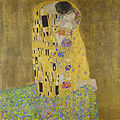 |
| 1909 | Interior of Villa Ortiz Basualdo was created by Gustave Serrurier-Bovy [33] in Mar del Plata, Argentina | Vapor Aymerich, Amat i Jover textile factory was built by Lluís Muncunill in Terrassa | | The main railway station was completed by Josef Fanta, Václav Jansa, Ladislav Šaloun, and Stanislav Sucharda in Prague | Ballets Russes premiered in Paris |  |
|---|
| Bellesguard and Sagrada Família Schools were completed by Antoni Gaudí in Barcelona | The building at Vidus iela, 11 was finished [34] by Konstantīns Pēkšēns in Riga, Baltic governorates of Russian Empire | Major Pessoa Residence [ pt ] was finished [35] by Francisco Augusto da Silva Rocha in Aveiro, Portugal |  |
| 1910 | Hôtel Lutetia was built by Louis-Charles Boileau and Henri Tauzin in Paris | Casa de Antonio Baena Gómez [ es ] was finished by Enrique Nieto in Melilla | The building of Glasgow School of Art by Charles Rennie Mackintosh was completely opened | Karuna Church was completed by Josef Stenbäck in Grand Duchy of Finland | "Pond Lily" Table Lamp, Model No. 344 and Jack-in-the-pulpit vase were finished [36] [37] by Louis Comfort Tiffany |  |
|---|
| "Meeting d'Aviation Nice" poster was created by Charles-Léonce Brossé | The Casa Briet was finished by Timoteo Briet Montaud in Alcoy, Valencian Community | National Museum of Finland was completed [38] by Herman Gesellius, Armas Lindgren, Eliel Saarinen, and Akseli Gallen-Kallela in Helsinki | Crematorium was completed [24] by Robert Belli, Henri Robert, and Charles l’Eplattenier in La Chaux-de-Fonds, Switzerland |  |
| 1911 | Michelin House [39] was built by François Espinasse in London | Casa Comalat [ ca ] was finished by Salvador Valeri i Pupurull in Barcelona | | Sprudelhof [ de ] spa complex was finished in Bad Nauheim, German Empire | Bolsheokhtinsky Bridge was finished in Saint Petersburg |  |
|---|
| The Circulo Industrial de Alcoy was finished by Timoteo Briet Montaud in Alcoy, Valencian Community | The Stoclet Palace* [40] was finished by Josef Hoffmann, Gustav Klimt, Fernand Khnopff, Franz Metzner, and Leopold Forstner in Brussels [41] |  |
| 1912 | Hector Guimard completed his own house in Paris | Casa Gasull and Institut Pere Mata were finished by Lluís Domènech i Montaner in Reus | | Municipal House was completed by Osvald Polívka, Alphonse Mucha, Josef Mařatka and Stanislav Sucharda in Prague | The katholikon of Marfo-Mariinsky Convent was finished by Alexey Shchusev in Moscow |  |
|---|
| Casa Milà* [1] was completed [42] by Antoni Gaudí and Josep Maria Jujol in Barcelona | Kallio Church was finished by Lars Sonck in Helsinki | Tolstoy House was finished by Fredrik Lidvall in Saint Petersburg |  |
| 1913 | The last métro station entrances of Hector Guimard were produced in Paris [43] | Episcopal Palace was finished by Antoni Gaudí in Astorga | | The Blue Church was finished by Ödön Lechner in Pozsony (now Bratislava) | Galería Güemes was completed by Francisco Gianotti in Buenos Aires |  |
|---|
| The building at calle Sant Llorenç 27 [ es ] was finished by Vicente Pascual Pastor in Alcoy, Valencian Community | Palace of Culture was finished by Marcell Komor [ hu ], Dezső Jakab, Aladár Körösfői-Kriesch, and Miksa Róth in Marosvásárhely (now Târgu Mureș, Romania) [44] |  |
| 1914 | Agoudas Hakehilos Synagogue was completed by Hector Guimard in Paris | Parc Güell* [1] was completed by Antoni Gaudí, Joan Rubió and Josep Maria Jujol in Barcelona | | Lyhdynkantajat were sculpted by Emil Wikström for Helsinki Central Station | La Primavera is painted by Galileo Chini |  |
|---|
| Church of Colònia Güell* [1] was left unfinished by Antoni Gaudí and Francesc Berenguer i Mestres in Santa Coloma de Cervelló | Eugenia Primavesi was painted by Gustav Klimt in Vienna | |
| 1915 | | Casa Tortosa [ es ] was finished by Enrique Nieto in Melilla | | Jan Hus Memorial was completed by Ladislav Šaloun in Prague | |  |
|---|
| 1916 | | Casa de Jacinto Ruiz [ es ] was completed by Emilio Alzugaray [ es ] in Melilla | | Kultaranta was finished [45] [46] by Lars Sonck in Naantali, Grand Duchy of Finland | Dream Garden favrile glass mosaic mural was made by Maxfield Parrish and Louis Comfort Tiffany in Philadelphia |  |
|---|
| Mercado de Colón was finished by Francisco Mora Berenguer in Valencia | The Palacio Baburizza was finished in Valparaiso, Chile [47] [48] [49] |  |
| 1917 | | Casa de David J. Melul [ es ] and Grandes Almacenes La Reconquista [ es ] were finished by Enrique Nieto in Melilla | | | The office building of the Holland America Lines was completed by Constant Mari Droogleever Fortuijnin and other architects in Rotterdam | 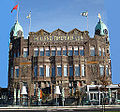 |
|---|
| The North Station by Demetrio Ribes Marco was inaugurated in Valencia | The Jack Pine and The West Wind were finished by Tom Thomson in Canada [50] | 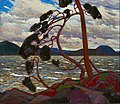 |
| 1918 | | Lluís Domènech i Montaner built his own house in Canet de Mar | | | |  |
|---|



















































